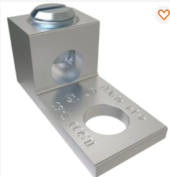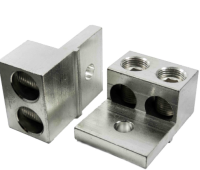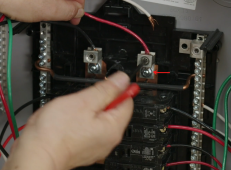SunCatcher
New Member
- Joined
- Dec 24, 2021
- Messages
- 62
LOL... well I did pull a lot of hair out to learn thisI'm more of an armature than you and really wish I knew what you just said. Seriously.
LOL... well I did pull a lot of hair out to learn thisI'm more of an armature than you and really wish I knew what you just said. Seriously.
I think it was just following up on what I suggested in #16. Seems the "AC load out" on the sol-ark is "only" rated 50 amps continuous.
When the grid is out it would be okay for the AC load out to power the shop since it won't deliver more than 50 amps.
But, if in normal operation (e.g., grid up) the shop draws more than that it would constantly be tripping the sol-ark breaker. So, for normal operation, a bypass is needed for the shop.
Let's look at the case where it would work, say the shop subpanel was a maximum of 45 amps and the case where it wouldn't work:
Note: only 1 phase is shown in the diagram for simplicity with a DPDT. In practice, you'd want one switch flick to change L1 & L2 simultaneously ...possibly this.
If it were less (say 45 amps) then it could be wired like this:
Here the built in transfer switch handles the shop.But... if the shop subpanel is 100 amps. Then they need to bypass so they have full power when the grid is available.
Hope that helps!
See Drawing Tools ; -) That was made from the OpenOffice tool which is an open-source replacement for the Microsoft Office suite (used the visio-like tool). But the Wiki page lists a lot of them.... I will admit that my hand sketching was not nearly a nice as yours.
I'd wait. You might find by 1 pm your batteries are charged and you're just throwing away solar power. Plus excess electricity is more versatile than excess hot water (you might have an EV in a decade).I am also thinking that I will research solar hot water tanks or perhaps separate solar panels specifically for the hot water tank to try and lower the daily load on the Inverter.
Not pleasant ones. If you're grid-tied you're always using solar power first and exporting excess so no need.I one time heard of someone who wired the hot water tank in such a way that one element was on grid and the other on solar. I tried to google that but haven't found it. Any thoughts on that?
Those drawing tools were cool... Thank you.See Drawing Tools ; -) That was made from the OpenOffice tool which is an open-source replacement for the Microsoft Office suite (used the visio-like tool). But the Wiki page lists a lot of them.
I'd wait. You might find by 1 pm your batteries are charged and you're just throwing away solar power. Plus excess electricity is more versatile than excess hot water (you might have an EV in a decade).
Not pleasant ones. If you're grid-tied you're always using solar power first and exporting excess so no need.
If the grid is out I'd want finer control because of cloudy days.
My interim solution is to just control when the water heater comes on via the breaker box. My long-term solution is to automate the hot-water tank and EV to come on when there's sufficient excess energy. Lot's of people have already set that up via something like home-assistant, but like any good politician I'm waiting for a disaster before I can get myself to spend the $$.
This thread has helped me quite a bit. It continues to develop nicely too.And thank you for helping... I am hoping that this thread will also help others.
Les
...I have a 200 Amp service panel ... 60 Amp [PV] ... over the 120% rule ... what are my options?
| What is a line-side tap you ask? It means putting the L1/L2 connection from the inverter between the 200 amp breaker in the load center and the meter. The 120% rule only applies when it's across the load center's backplane, with a tap you can't go wrong. If you do the math you'll see you can never overload anything that way. The image to the right shows a line-side tap to give the idea. Knowledgable & DIY Friendly building inspectors /codes will let you do lugs if there's plenty of room in the load center because there's a breaker in the Sol-Ark. Lugs are an inexpensive (?) /simple way to go. In this setup L1/2 from the inverter connect to the supply side of the breaker in the load center. But not all inspectors are that savvy and may tell you can't do it. They may try and disallow the line side tap altogether. Or your load center may just not be able to support it. | Example of a line-side tap with maximum components 
|
- Replace the panel or add a second panel (rather expensive and not needed)
- Replace the main breaker with a 175 Amps (175+60=235 < 240) (pretty easy/cheap but cuts night-time power to under <= 175 amps)
- A Line-Side Tap (probably the most practical and possibly the cheapest).
You'll probably want an electrician to do this for you anyway as either the service meter needs to be pulled or you have to turn the power off at the pole to make it safe to work on. A certified electrician also can get away with things an inspector would fail if a DIYer did regardless of how safe it is.
My 6kw of inverter easily covers the critical loads at my place including the A/C blower (furnace blower) (not the outside condenser) all the kitchen, including 2 chest freezers. All the lights, and receptacles on the first floor for computers, TV's internet etc. All that is covered by about 600w continuous. Kitchen draw can easily add an additional 1500w from microwave or crockpot etc.I recognize that a 12 K system with 9000 watts
-lights and basic household plugs which run your computers etc
- fridges and freezers
- well pump.... we must have water, deep well @30Amp
- hot water tank.... at the end of the day someone needs a shower
- shop... the breakers for the air compressor can be left off most the time
We do have battery storage for up to one week and possability to hook up a generator.
 Replacement dual lug ->
Replacement dual lug ->  or
or 

40A PV breaker, but only operate up to 80% for continuous current, 32A inverter output x 240V = 7680W
Therefore, a number of inverters of that rating.
You're aren't likely to find a 175A main breaker. I'm aware of 200A and 150A for one particular panel I have.
"Line side tap" is one approach, another circuit taken off between main breaker and meter.
That may be accomplished with an insulation piercing connector.
There are meter socket adapters available with an extra tap. My utility PG&E offered that, but 40A max.
It has occurred to me that there is a lot of marketing hype designed to give the impression that "our brand" solar system is going to abundantly supply all your needs and wants " To Infinity and beyond".My 6kw of inverter easily covers the critical loads at my place including the A/C blower (furnace blower) (not the outside condenser) all the kitchen, including 2 chest freezers. All the lights, and receptacles on the first floor for computers, TV's internet etc. All that is covered by about 600w continuous. Kitchen draw can easily add an additional 1500w from microwave or crockpot etc.
So as long as your not stacking the well pump ontop of the water heater ontop of the air compressor you should be good. Depending on how serious your off-grid prepping is, you might consider a large propane tank for a propane water heater and propane for backup generator. Hotwater alone is a huge power consumer. (assumeing you dont go with one of the fancy new extremely expensive heat pump units)
Ah... thank you.Just happened across an image of a breaker panel clearly showing the lugs bolted on (look for the arrow in the photo below) and thought I'd post it.
Going back a few posts, there was concerns about stepping down the main breaker to 175 amps.
That's 42,000 watts!
If that's not enough, how is a 9,000 watt Sol-ark going to cover any meaningful portion of your loads.
My Schneider XW 6848 also has a 60 amp breaker in the main panel, so I've got a 150 amp main breaker. That was no where near $250, I think it was more like $75
Also, I can program the Schneider to limit grid draw. It can be programmed for a 20 amp breaker for example. Not sure if the Sol-ark supports this feature.
Sol-Ark inverter can process 12 kW of PV and produce 8 kW of AC, that's a good balance for battery system.
While grid connected, if battery full only 8kW of the 12kW can be harvested, but that's just "over paneling", will sustain 8kW for more hours.
Given how much cheaper PV is these days than balance of system, that isn't a bad thing to do.
Note also that 8 kW of AC is no more than 4kW on each of two 120V phases. And really "8 kVA", can drive an 8 kW resistive load but not as large a load with < 1.0 power factor, such as motors and anything with rectifiers and capacitors such as power supplies.


